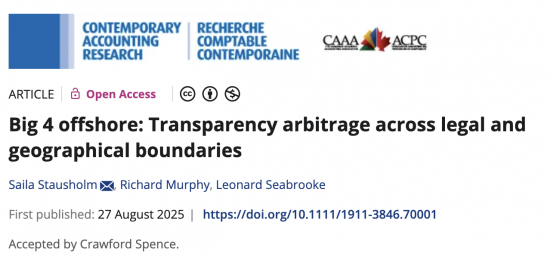Wiley published this yesterday:

This paper has been in the making for about six years, and I offer my thanks to Len and, most especially, Saila for their persistence with it, building on the idea that started us all on this trail. It has now been published in one of the highest-ranked accounting journals.
The abstract is as follows:
How do global firms manage conflicting constituencies in complex markets? The Big 4 accounting firms have expanded their size and scope to the extent that they need to relate to different constituencies simultaneously, sometimes on controversial issues. This is particularly relevant given their engagement in aggressive tax planning services alongside their traditional professional obligations, as this generates a conflict between discretion offered to “offshore” clients and accountability offered to other stakeholders. This requires strategic duplicity—sending differentiated signals to different stakeholders. We suggest that firms use organizational partitioning across legal structures and geographies to enable strategic duplicity. We test this by collecting a unique data set on the Big 4's ownership structures and staff numbers across all locations, showing that their organizations are heavily segmented. We show that the Big 4 use this geographical and legal differentiation to send contrasting signals to constituents about their organizations, engaging in a type of strategic duplicity that we term transparency arbitrage, in which “onshore” stakeholders receive a signal of transparency and “offshore” stakeholders receive a signal of discretion. This duality enables them to engage in controversial issues with conflicting stakeholders.
The paper is free to access and can be found here.
Thanks for reading this post.
You can share this post on social media of your choice by clicking these icons:
There are links to this blog's glossary in the above post that explain technical terms used in it. Follow them for more explanations.
You can subscribe to this blog's daily email here.
And if you would like to support this blog you can, here:


 Buy me a coffee!
Buy me a coffee!

Thanks for the link.
‘Sending contradictory signals’ a good way of putting it, but still quite surprised they published…’Strategic duplicity’!
Co-ordination Centres, Belgium, 1980s. = profit washing machine for Euro profits of multinationals. Covered them in the International Taxation (aka “Applied Deviousness”) part of my MBA. EU pressure eventually froced their closure – but at one point the offices for the Coo-Cs were lined up along Ave Franklin Rooseveldt, all orchestrated by the usual suspects (of which there were a few more then). “strategic duplicity” – like it.
Agreed – and a terribloe history assopciated with them, knowingly facilitated by both Belgium and the Netherlands.
Isn’t this just another variant of the absurd “Chinese walls” so fashionable in the professions thirty years ago? In decency they should at least show they have some new ideas.
No, very much more than that if you read the paper.
Ah! They have been busy. Nice to find ot how they have been spending their creative time. I will try to make the time to read it.
Thanks
[…] The Big 4 offshore: Transparency arbitrage across legal and geographical boundaries […]